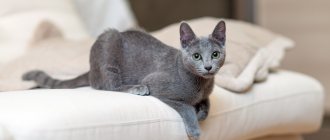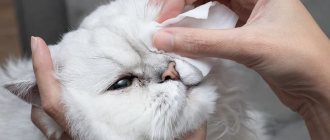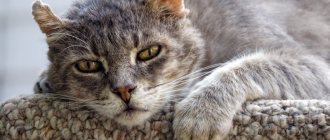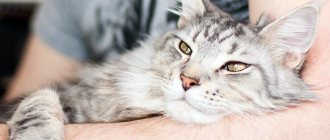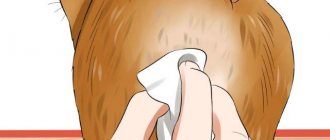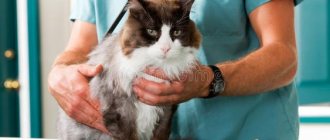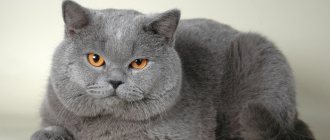Digestive system
The cat's digestive system consists of:
- esophagus;
- stomach;
- small intestine;
- duodenum;
- jejunum;
- liver;
- large intestine.
The esophagus has a hose-like shape of a relatively small size, and connects the animal’s mouth and its stomach. The esophagus originates from the inner base of the mouth, extends through the neck and chest, passes close to the heart, extends through the muscles of the diaphragm, and connects to the stomach. It is important to note that the esophagus is equipped with special muscles that push food into the stomach, producing synchronous movements similar to waves. The esophagus is one of the most difficult organs in terms of surgical treatment, as it is difficult to access and extremely difficult to heal.
The cat's stomach is single-chambered, and is distinguished by the location of the mucous membrane on its inner walls. The cat's stomach is adapted to accommodate a large amount of food, but it is almost never completely filled, since cats are not prone to gluttony (the vast majority). Also, the inner surface of the stomach is dotted with folds, which have an additional mechanical effect on the process of breaking down food. Food processed by gastric juice enters the duodenum through the pyloric sphincter. Most often, eaten food remains in the stomach for about 12 hours.
The small intestine is a tubular organ that connects the stomach and large intestine. Often the length of a cat's small intestine is about 1.5-2 meters, and includes the duodenum, jejunum, and ileum.
The duodenum is small in size and serves to mix food with liver and pancreatic enzymes, which is extremely important for digestion.
The jejunum is the longest part of the small intestine, and its internal walls are dotted with thin hairs, which, when in contact with food that comes into contact with them, penetrate into it and suck out all the useful substances. It is here that the final extraction of all useful substances from food occurs, after which it enters the ileum, and then the large intestine, where it turns into feces.
Internal organs
Of course, a dog's anatomy is not limited to the skeleton and sensory organs. Internal organs occupy a special place in the anatomy of a dog.
Expanded image of a dog's internal organs
Digestive system
It originates from the mouth, where food enters. Afterwards, the food moves through the esophagus and reaches the stomach, where the incoming food is digested. Gastric juice and enzymes grind food into a homogeneous mass called zymus.
Next, the small intestine comes into play, interacting with the pancreas, duodenum and liver. The walls of the small intestine transmit incoming substances into the blood.
Next in line is the large intestine, where the digested food goes. By the time it enters the large intestine, all useful vitamins, minerals and other substances have already been received. Feces are formed from the remains of waste food.
Circulatory system
The main circulatory organ in dogs, like in humans, is the heart. Through the arteries, blood enters each internal organ and circulates through the veins to the heart. The heart is located between the 3rd and 6th ribs in front of the diaphragm.
The heart consists of four chambers and is divided into the right part, where venous blood circulates, and the left part, where arterial blood flows. The parts of the heart are in turn divided into the atrium and the ventricle. The walls of the heart consist of an inner layer - the endocardium, an outer layer - the epicardium and the cardiac muscle of the myocardium.
Important! The size and rate of its contractions depend on the breed, sex and age of the pet.
Respiratory system
The respiratory organs provide the supply of oxygen. The respiratory system consists of two sections:
- upper. Consists of the nasal cavity, nasopharynx, trachea and larynx;
- lower. Consists of lungs and bronchi.
The physiology in this case is as follows: air enters through the nostrils, and their size depends on the breed of the dog. In the nasopharynx, the incoming air undergoes a warming process, and the nasal glands act in this process as a filter that rejects dirt and dust. The incoming air then continues to move through the larynx. After this comes the trachea. The air then reaches the lungs, which contain blood vessels.
For your information! On average, a dog takes 10-30 deep breaths per minute. Small breeds breathe more frequently than larger breeds. The frequency of inhalations may increase depending on the emotions that the animal experiences, and this indicator may look different.
Urinary system
The dog's urinary organs are designed to empty the body and maintain an acceptable level of water-salt balance. The kidneys produce hormones that control hematopoietin and renin. That is why disruption of the urinary system leads to a number of diseases and often death.
Excretory system
The activity of the excretory system depends on the kidneys. The kidneys work with the bladder through the ureters and end in the urethra. The main task of the excretory system is to remove urine from the body.
The kidneys are equipped with nephrons, which are surrounded by blood vessels. The older the animal, the more often problems with this internal organ may occur.
Reproductive system
The reproductive system is intertwined with the excretory system. In male dogs, the urinary tract is the vas deferens. In addition to the testes, male dogs have a prostate, which provides life to sperm.
The reproductive organ of females is the uterus. The dog's uterus is equipped with horns to which the ovaries, fallopian tubes and vagina are attached. Bitches go into heat twice a year, but it still depends on the type of breed.
Note! In northern breeds, estrus occurs once a year and lasts 28 days. When finished, the female can be mated
Muscular system and skin
The muscular system is responsible for the activity of the dog. There are three types of muscles:
- smooth. Passes along the walls of all blood vessels;
- striated is attached to the skeleton;
- cardiac.
Dog muscles
The muscles are enveloped in nerve endings that transmit signals to the dog’s brain.
The skin, like the muscle system, has a number of functions. It reacts to any changes occurring in the pet and regulates body temperature. It is permeated with vessels and glands, and on the surface layer there are hair roots.
Knowing the anatomy of a pet will make life easier for its owner, because it is not always possible to understand the reasons for the anxiety of your four-legged friend. And so, having an idea of the work of internal organs, you can provide him with timely assistance.
Circulatory system
The circulatory system in cats works the same way as in other mammals: the heart pushes blood through arteries that have elastic walls and rhythmically carry out contraction and relaxation movements. It is thanks to such movements that arteries located close to the skin can be felt, and this is called the pulse. The cat's pulse is easiest to detect on the inside of the thigh, and in a healthy animal it should range between 100-150 beats per minute.
The cat's brain absorbs 15-20% of the blood, the muscular system absorbs up to 40% of the total blood, and about 25-30% of the blood goes to the internal organs. During physical activity, muscles can absorb up to 90% of the blood, which is why cats get tired so quickly, but can focus maximum strength for a short period of time.
Integumentary tissues
The skin and fur of cats perform a protective function.
They protect the body from the penetration of infections and microorganisms, mechanical damage, ultraviolet rays, thermal and chemical influences. The top layer of skin is called the epidermis. It consists of cells and intercellular substance that firmly connects them to each other. Immediately behind it comes the basal layer, and then the dermis.
It contains nerve endings, hair follicles (hair roots and the surrounding space), sebaceous glands and small blood vessels (capillaries). There are several types of sebaceous glands.
| Location on the body | What produces |
| All over the body near the hair roots | Grease that lubricates the fur |
| In the anal area and on the paw pads | Substances with an odor that attracts individuals of the opposite sex (pheromones) |
| On the face | A substance that cats use to mark their territory. |
Separately, it is worth noting the claws, which are modified skin. Inside them are nerve endings and blood vessels.
The part of a cat's hair located above the skin consists of dead epidermal cells layered on top of each other. They reflect light, so the wool shines and shimmers in the sun.
From each follicle several hard guard hairs grow, a maximum of six. Each of them is surrounded by undercoat - soft and fine hairs. In addition, there are special muscles responsible for raising the fur on end. This muscle attaches to each follicle.
Endocrine system
The endocrine system is primarily responsible for hormones and their production in the corresponding organs. Thus, the cat’s brain produces antidiuretic hormone, oxytocin, corticotropic hormone, adrenocorticotropic hormone, cortisol and growth hormone.
The adrenal glands produce a lot of other hormones, the main purpose of which is to regulate metabolism, and are also responsible for behavioral characteristics. The adrenal glands also produce cortisol, a small portion of testosterone, as well as epinephrine and norepinephrine.
Limbs
The upper regions that make up the skeleton were discussed above. A cat's front paws are different from their back paws. As mentioned above, it moves on the fingers. The heel is visible on the hind legs. It may look like it's a knee. But it is located at the level of the lower abdomen. There are five fingers on the forelimbs. At the same time, the fifth one is greatly shortened and does not touch the surface while walking. The last phalanx in each finger acts as a base for the claw. It is pulled into the pad using a special ligament. It is missing only on the first finger. It acts as a rudiment and grows separately. The claw on it does not retract. The hind limbs, unlike the forelimbs, are quite rigidly attached to the sacrum. The bones in this part are more developed and longer. The hind legs have 4 toes. Here the fifth digit, which is present on the forelimbs, is presented as a skin protrusion. The weight of the animal's body is distributed evenly over the entire foot of the hind paw. Like other mammals, the knees bend forward and the elbows bend backward. A distinctive feature of the forelimbs is also the rotating wrists.
Nervous system
The nervous system of cats is divided into central and peripheral. Each of these systems in a cat performs functions that are standard for most mammals.
The central nervous system consists of the brain, brain stem and the so-called spinal cord. The central nervous system is the most important in the body of any living creature, and simple and complex reactions, as well as some reflexes, depend on it. In addition, the central nervous system interacts with the peripheral and autonomic ones, ensuring their functioning and control.
The peripheral nervous system is responsible for the cat's conscious motor abilities. So, thanks to this system, a cat can move its paws, extend its claws, run, and generally lead the lifestyle that it leads. Also, the peripheral nervous system transmits pain impulses to the central nervous system from any part of the body where peripheral nerve endings are present.
External structure of a cat
The anatomical structure of a cat is incredibly organic and cannot but please the eye. Small size, cute face, soft paws, long flexible tail, fluffy fur - all this distinguishes cats from other animals. All parts of the body of these animals have their own charm and practical purpose, but at the same time they can hide certain secrets. For example, paws at first glance are completely harmless, but they hide the main weapon - the ability to release claws. Just like the cat itself, a seemingly affectionate pet, but at the same time a real predator.
Cat head
Eyes
The structure of a cat’s eye differs little from that of a human and a cat sees according to the same principle as we do – it reacts to light. The pupil tends to increase or decrease with the help of a special muscle, and its size depends on the amount of light. In the dark, a cat sees with the help of a special layer of the choroid - tapetum. It serves as a mirror that reflects the light received by the eyes, and due to this, vision is sharpened. The tapetum is also the reason why a cat's eyes glow in the dark.
Ears
The structure of a cat's ear allows it to detect more than 100 sounds, including ultrasonic sounds, with the help of which cats communicate with kittens. The auditory canals also contain an incredible number of nerve endings and more than 10 muscles. This is why cats can change the position of their ears on their heads - press them down, bend them, turn them towards the sound, etc.
Language
The structure of a cat's tongue is of some interest, primarily due to the fact that the animal manages to drink only with its help. The tongue is long, very flexible and, unlike, for example, a dog’s, very rough. The “sandpaper” effect occurs due to the keratinized papillae, which help retain food and also act as a kind of brush for cleaning the fur. In addition, the tongue performs a function that is familiar to us - recognizing the tastes of food. A cat can taste salty, bitter, sweet and sour.
Jaws and teeth
The structure of teeth in cats is of great importance, since teeth are one of the most important tools for hunting or, conversely, protection. An adult cat has 30 teeth, which are symmetrically located on the upper and lower jaw. The main tool for catching prey is 4 canines - these are the longest and sharpest teeth of a cat, 2 on each jaw on the sides of the incisors. With the help of incisors, cats tear off pieces of food, but cats' jaws are not adapted for chewing, so food begins to break down already in the oral cavity under the influence of saliva.
cat body
According to their build, cats are divided into three types: heavy, light and medium. The severe type is characterized by the presence of a large cat head on a short neck, a wide chest and rather short legs and tail. Lightweight - with a slender body, a long neck and a narrow head, as well as a long tail and paws. The medium type is somewhere between heavy and light, and most cats, especially non-pedigree cats, are of the medium type. But the appearance, weight and size of a cat does not depend on its build; there are both representatives of the heavy type, but small in size, and large slender cats.
Paws and claws
The structure of a cat's paw is especially curious because the claws can extend or retract. Cats have 5 toes on their front paws, but one is shortened and does not reach the ground. There are only 4 toes on the hind legs, the big one is missing. It is also noteworthy that the cat walks only on its toes, which, of course, contributes to noiseless movement. A cat's paws concentrate all the sweat glands and many nerve endings, so the cat can also receive information by touching an object with its paw.
The structure of the claw is unique; most breeds have crescent-shaped claws, with the exception of Persian cats with claws that are more reminiscent of hooks, which pose a particular danger when scratching, as they get under the skin.
Tail
The structure of a cat's tail is usually divided into 3 parts: the root, the stem (actually, the tail itself) and the tip. The root consists of 4-6 short and wide vertebrae, the stem of 10-15, which are cylindrical in shape, and at the tip there are 5-7 of the thinnest and smallest vertebrae, the very last of which may be undeveloped, often sharp. Between the vertebrae there are cartilages and joints, they provide the tail with flexibility and mobility. The tail can help a cat maintain balance, but its significance is more visual, and it is also one of the tools of the cat's language.
Musculoskeletal system
The cat's body has two main types of muscles: smooth muscle and striated muscle. Smooth muscles are found in all the internal organs of the cat, and are directly connected to the autonomic nervous system, thereby ensuring the work and unconscious functioning of the internal organs, an excellent example of which would be the esophagus and the heart.
The striated muscles are attached to the skeleton and provide the cat with physical strength, the ability to move, hunt and fight. The striated muscles are familiar muscles that we can feel on the limbs and body of the pet.
An important part of the musculoskeletal system of a cat are tendons, ligaments and joints, which in all cats are distinguished by strength, flexibility and enviable elasticity until old age.
The cat's shoulder girdle, which has a unique structure, deserves special mention. Thus, in almost all mammals, the bones of the forelegs are connected to the body with the help of the collarbone, but in cats, the bones of the limbs are connected to the body exclusively with the help of muscles, which provides them with incredible mobility.
Skeleton and its parts
What a cat's body consists of can be found out through anatomy - a branch of biology that studies the structure of the body. First, you should get acquainted with the frame that holds all the important organs, that is, with the skeleton.
There are about 40 more bones in the cat skeleton than in the human skeleton, amounting to 244-250 pieces. The exact number depends on the length of the tail.
Skull and teeth
The cat's skull has 24 bones. 13 of them are on the facial part, and 11 are on the cranial part. Compared to other mammals, a cat's head is quite small in relation to its body, but it has a well-developed brain inside its skull.
The strong jaws of mustachioed pets have 30 sharp teeth. A smaller number (26) is typical only for kittens. By 7-8 months, their milk teeth are replaced by molars, and the dentition is replenished with missing molars.
Spine and tail
A cat's flexibility is due to the amazing mobility of its vertebrae. They can all be divided into 5 departments:
- cervical, consisting of the most massive bones;
- thoracic, to which 8 pairs of ribs are attached;
- lumbar, surrounded by muscles that hold the contents of the abdominal cavity;
- sacral, consisting of 3 fused vertebrae;
- caudal, including from 12 to 28 vertebrae.
Thanks to the massiveness of the cervical vertebrae, the animal can easily turn its head almost 180°, and thanks to its underdeveloped collarbones, it can easily penetrate the narrowest crevices.
The tail plays a special role. With its help, the cat maintains balance while jumping or falling from a height.
Four paws, and there are scratches on them
A cat's paw bones are not directly attached to the skeleton. They are held in place by muscles and tendons.
The hind limbs differ from the front limbs in being longer and having fewer fingers. There are as many of them in front as there are in humans, and in the back there are only 4.
Each of the fingers is equipped with a sharp claw. In a calm state, the claws are retracted into a special pouch, but when you press on the pad, they can be returned back. This is very convenient when trimming overgrown claws.
Due to the unusual location of the knee (right under the belly), cats always walk on tiptoe. This bizarre method of transportation is not only silent, but also very safe. When jumping, the paws absorb all the energy expended, so landing from a great height is soft and quiet.

